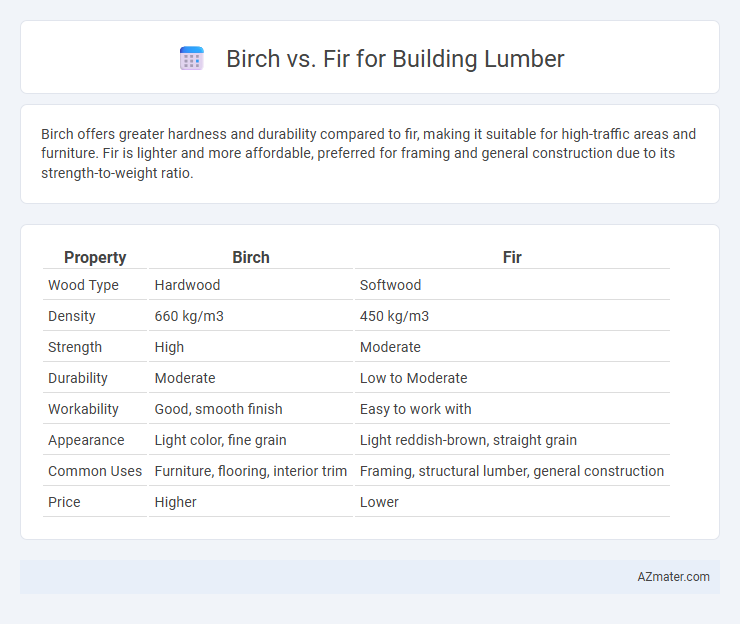Birch offers greater hardness and durability compared to fir, making it suitable for high-traffic areas and furniture. Fir is lighter and more affordable, preferred for framing and general construction due to its strength-to-weight ratio.
Table of Comparison
| Property | Birch | Fir |
|---|---|---|
| Wood Type | Hardwood | Softwood |
| Density | 660 kg/m3 | 450 kg/m3 |
| Strength | High | Moderate |
| Durability | Moderate | Low to Moderate |
| Workability | Good, smooth finish | Easy to work with |
| Appearance | Light color, fine grain | Light reddish-brown, straight grain |
| Common Uses | Furniture, flooring, interior trim | Framing, structural lumber, general construction |
| Price | Higher | Lower |
Introduction to Birch and Fir as Building Lumber
Birch and fir are two common types of building lumber favored for their unique structural properties and aesthetic qualities. Birch wood is known for its hardness, fine grain, and pale color, making it ideal for interior applications that require durability and a smooth finish. Fir, particularly Douglas fir, offers high strength-to-weight ratio and stability, making it a popular choice for framing and structural components in construction projects.
Botanical and Physical Differences
Birch lumber, derived from Betula species, features a fine, uniform texture and light color, offering excellent hardness and strength suitable for detailed woodworking and furniture. Fir lumber, primarily from Abies species, exhibits a coarser grain with more visible knots, valued for its straight grain, moderate strength, and resistance to warping, making it ideal for structural framing and construction. Botanically, birch trees belong to the Betulaceae family with broadleaf deciduous characteristics, while fir trees are coniferous evergreens in the Pinaceae family, influencing their wood density and grain patterns.
Strength and Durability Comparison
Birch lumber offers moderate strength and hardness, making it suitable for furniture and interior applications, but it is less durable and prone to moisture damage compared to fir. Fir, specifically Douglas fir, is renowned for its exceptional strength-to-weight ratio and superior durability, commonly used in structural framing and outdoor construction due to its resistance to warping and decay. When choosing between birch and fir for building lumber, fir provides better long-term performance in load-bearing and exterior environments.
Workability and Machining Properties
Birch offers superior workability for building lumber due to its fine, uniform texture and excellent machining properties, which allow for smooth cuts and minimal splintering. Fir, while strong and lightweight, tends to have a coarser grain that can cause more wear on tools and requires more careful handling during machining. Consequently, birch is preferred for precise woodworking projects where ease of shaping and finishing are critical.
Appearance and Grain Patterns
Birch lumber features a fine, uniform grain with a pale, creamy color and subtle reddish tones, making it ideal for smooth, elegant finishes in furniture and interior trim. Fir lumber displays a more pronounced, straight grain with a warm reddish-brown hue, providing a rustic and natural aesthetic suitable for structural uses and exposed beams. Both woods offer distinct visual qualities, with birch emphasizing smoothness and brightness, while fir highlights texture and warmth in building projects.
Resistance to Decay and Insects
Birch lumber exhibits moderate resistance to decay and insects but generally requires protective treatments for longevity in outdoor or high-moisture environments. Fir wood, especially Douglas Fir, offers better natural resistance to decay and insect damage, making it a preferred choice for structural applications exposed to harsh conditions. The durability of Fir, combined with its strong cell structure, often results in enhanced performance and longer life in building lumber compared to Birch.
Cost and Availability in the Market
Birch lumber generally commands a higher price than fir due to its hardness and aesthetic appeal, making it less common for structural framing but favored for finishing and furniture. Fir is more widely available and cost-effective, commonly used in construction for its strength, straight grain, and ease of workability, which drives its predominant market presence. Market availability of fir surpasses birch significantly, influencing purchasing decisions for large-scale building projects focused on budget and supply consistency.
Environmental Impact and Sustainability
Birch lumber offers moderate sustainability with its relatively fast growth rates and widespread availability, resulting in a lower environmental footprint compared to slower-growing species. Fir, particularly Douglas fir, is highly regarded for its sustainability due to efficient carbon sequestration and certifications like FSC, promoting responsible forest management. Both woods provide renewable options, but fir often outperforms birch in environmental impact assessments due to superior growth-to-harvest cycles and greater durability, reducing the need for frequent replacement.
Best Applications for Birch vs Fir
Birch is ideal for interior applications such as cabinetry, furniture, and flooring due to its fine grain, hardness, and smooth finish, offering excellent durability and aesthetic appeal. Fir lumber excels in structural uses like framing, beams, and outdoor projects because of its strength, straight grain, and resistance to warping and splitting. Choosing between birch and fir depends on the specific requirements of strength versus appearance and workability in building projects.
Conclusion: Choosing the Right Lumber for Your Project
Birch offers a smooth finish and excellent strength, making it ideal for furniture and interior applications, while fir provides superior durability and resistance to warping, suitable for structural framing and outdoor projects. Considering the specific demands of your project, such as load-bearing requirements and aesthetic preferences, will guide the optimal lumber choice. Prioritize fir for long-lasting structural integrity and birch for refined appearance and fine woodworking.

Infographic: Birch vs Fir for Building Lumber
 azmater.com
azmater.com